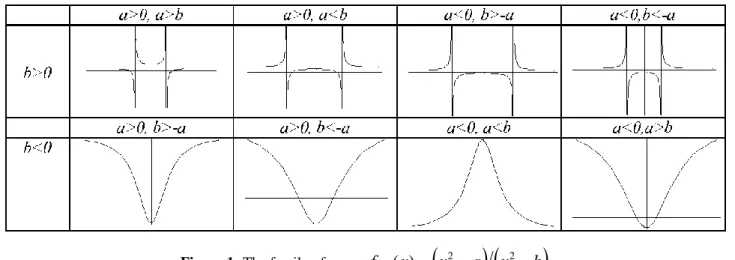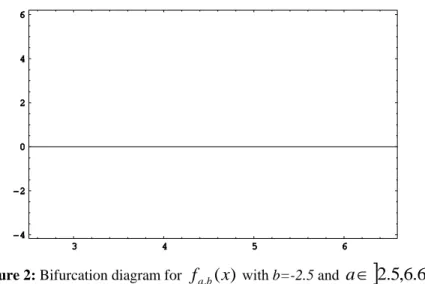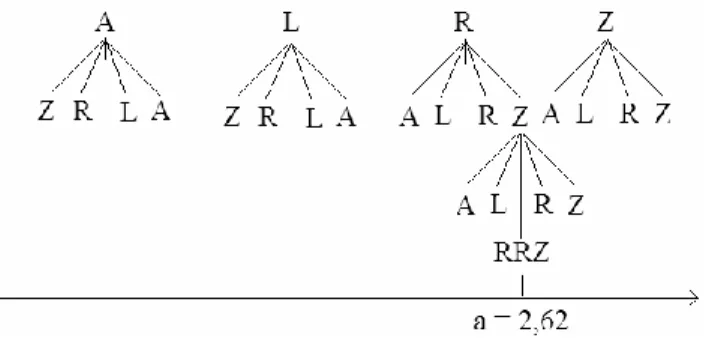Asian Online Journals (www.ajouronline.com) 69
Symbolic Dynamics for Real Rational Maps
João Cabral
Department of Mathematics of the Azores University Ponta Delgada, Portugal
_________________________________________________________________________________
ABSTRACT— This work is an attempt to study the dynamics of real rational maps
f
abx
x
a
x
b
2 2
,
(
)
,using symbolic dynamics. It is given an example that illustrates how the topological entropy can be calculated using kneading theory and Markov partitions in this family of rational maps.
Keywords—Rational maps, symbolic dynamics, topological entropy, Markov partitions
_________________________________________________________________________________
1.
INTRODUCTIONThe family of maps
f
a,b(
x
)
x
2
a
x
2
b
is a large and distinct group of functions that are smooth, with degree zero, from a circle to itself, having two critical points, zero and infinity, and not onto. Depending of the parameters a and b we can organize this family in eight different groups as shown in figure 1. Each group has its own behavior.Figure 1: The family of maps
f
a,b(
x
)
x
2
a
x
2
b
In this paper we will study only the dynamics of the map
f
a,b(
x
)
x
2
a
x
2
b
with a>b, a>0, b>0. With these restrictions the Schawrtzian derivativeS
f
a,b(
x
)
3
2
x
2 is always negative and the roots of)
(
,
x
f
ab are super-stable fixed points and this map have one critical point at x=0.The dynamics of
f
a,b(
x
)
is complex, but easy to understand with the proper tools. The goal of this work is to add one more tool to understand it, using tools already known in the study of the logistic map as symbolic dynamics and Markov partitions. To give one idea about of the complexity of the behavior off
a,b(
x
)
it is enough to see the bifurcation diagram shown in figure 2.Asian Online Journals (www.ajouronline.com) 70
Figure 2: Bifurcation diagram for
f
a,b(
x
)
with b=-2.5 anda
2
.
5
,
6
.
6
So, in section 2 and 3, using standard symbolic dynamics it is introduced admissibility rules of iteration sequences associated to
f
a,b(
x
)
, and will be presented the structure of the set of admissible sequences, building one kneading sequence tree. The techniques of symbolic dynamics are based on the Kneading Theory for one-dimensional multimodal maps, developed by Milnor and Thurston, see [4] and Ramos, J.S. [5].Since Kneading theory is an appropriate tool to obtain a topological classification of the one-dimensional maps this works intends to explore some results that can create a possibility of extension of it for the study of rational maps.
2. SYMBOLIC DYNAMICS
Let
d
b
,e
b
, the alphabetH
A
,
D
,
L
,
O
,
R
,
E
,
Z
, and the set
P
N0of symbolic sequences of the elements of P, withN
0
0
,
1
,
2
,...
. Now, taking the application
E
D
f
R
i
N n n a,b b a:
\
,
0 ,
defined by,
0
,
0
,
0
,
)
(
,
)
(
, ,
e
(x)
f
if
Z
e
(x)
f
if
R
(x)
f
if
O
(x)
f
d
if
L
d
x
f
if
A
x
i
n a,b n a,b n a,b n a,b n b a b a ,as we can see in figure 3.
Figure 3: The partitions of real axis
If now we consider the shift operator
:
,
X
0X
1X
2...
X
1X
2X
3...
we have the commutative diagramAsian Online Journals (www.ajouronline.com) 71
b a b a fi
i
b a , , , withR
f
D
E
N n n b a,
\
0 ,
, and ∑ is the symbolic space with alphabet P,
.We can introduce in Ω and order, induced lexicographically by the order in the real axis, R, with a parity defined by the subintervals where the function
f
a,b(
x
)
is decreasing. So, we haveA
L
O
R
Z
, when the parity is even and
Z
R
O
L
A
, when the parity is odd.Definition 2.1. We say that
X
Y
forX ,
Y
, iff
k:
X
i
Y
i,
0ik and k X X nal k X X nalY
X
k k ) ( ... ) ... ( 1 1 1 1)
1
(
)
1
(
, where
nal
(
X
1...
X
k1)
is the number of times that the symbols A and L appear in(
X
1...
X
k1)
.
We have, as example, using the definition 2.1.,
(
RZA
...)
(
RZL
...)
and(
RZR
...)
(
RZZ
...)
. 3. TWO METHODS, THE SAME ENTROPY VALUEThe orbit of an element x is the set formed by the images of the successive compositions, or iterations, of
f
a,b(
x
)
. If we construct a correspondence of each composition image, to a letter of the alphabet H, that identifies the partition of the real axis where the image is included, each orbit corresponds to a sequence in ∑.With some calculus we can see that the values in the left neighborhood of x=d and the values in the right neighborhood of x=e, have the same sequence in ∑. We will designate these points by p-points, associated to P sequences in Ω. By the same reason we will designate the values in the right neighborhood of x=d and the values in the left neighborhood of x=e as s-points, associated to S sequences in Ω.
Using the map
i
a,bwe introduce the kneading data (P,Q,S), where Q codifies the orbit of the critical point x=0, P codifies the orbit of the p-points and S codifies the orbit of the s-points. As an example if we take a=4.01 and b=2.5, on the iteration off
a,bwe will have the kneading data
,
(
)
,
(
)
,
,
Q
S
ZARZ
ARZR
ZARZ
ZRZR
ZARZ
P
.Looking at figure 4 we can see all the possible sequences to (P,Q,S), trough a combinatorial tree constructed using the order, and parity defined in definition 2.1., and notice that the minimal sequence is
AZ
and the maximal sequence is
Z
with fixed b. But not all the sequences are admissible in each family of mapsf
a,b.Figure 4: Tree of all admissible sequences for x=0.
Taking b=2.5 and
2
.
5
a
we can characterize the admissible sequences, using a transition matrix T. If we define the matrix T as the matrix where the rows and columns are labeled by the elements of the alphabet H, such asAsian Online Journals (www.ajouronline.com) 72
0
1
1
1
1
1
0
0
1
1
0
0
0
1
1
1
T
.It produces the following result.
Proposition 3.1. Let
X
(
X
1,
X
2,...,
X
i,...)
be an admissible sequence. Then X satisfies the following rules:1)
1
1 , i
i X XT
;2) If
X
i
L
orX
i
R
then
i(
X
)
Q
, with Q the kneading sequence of the critical point x=0.Proof
With the action of
f
a,beach real interval changes and it is transferred in another interval or in the union of real intervals. Using the results of Lampreia, J.P. and Ramos, J.S. [1] on the mapf
a,b(
x
)
x
2
a
x
2
b
with b=2.5 and2
.
5
a
, and considering the partitions of the real axis labeled by the symbols A, L, R,Z, using the symbol O for x=0, having
A
L
O
R
Z
, when the parity off
a,bis even andA
L
O
R
Z
, when the parity off
a,b is odd, we can see with simple calculus, that T represents the iteration of the elements of each partition byf
a,b, following naturally the results 1) and 2). ■Figure 5: Markov partition for ZARZ, a=4.01 and b=2.5.
Taking proposition 3.1., and the real axis as we can see in figure 5, associating each
x
i, i=1,2,…,k to a symbolic sequence
i
Q
(k)
...
Q
(k) , whereQ
(k)is the corresponding kneading sequence to)
0
(
,b
a
f
; eachy
i, i=1,2,…,k to a symbolic sequence
i
P
(k)
...
P
(k) , whereP
(k)is the corresponding kneading sequence tof
a,b(
p
)
, with x=p a p-point; eachz
i, i=1,2,…,k to a symbolic sequence
( )
( )...
k k iS
S
, whereS
(k)is the corresponding kneading sequence tof
a,b(
s
)
, with x=s as-point we can build, for a=4.01 and b=2.5, see figure 5, the transition matrix
0
0
0
1
0
0
0
0
0
0
1
1
1
0
0
0
0
0
0
1
0
0
0
0
1
1
0
0
0
0
0
0
0
1
1
1
M
.By Misiurewicz, M. and Szlenk, W. [3], we can calculate the topological entropy,
k k k b a topf
L
h
,log
lim
1 , whereL
k is the number of laps off
a,b
...
f
a,b
f
ak,b, that is, the number of sub-intervals wheref
ak,bis monotone, orh
top(
f
a,b)
log
max(
M
)
, where
max(
M
)
is theAsian Online Journals (www.ajouronline.com) 73
spectral radius of the transition matrix M associated to the Markov partition. In this case we have
51879
.
0
)
92756
.
1
log(
)
(
a,b
topf
h
.Another route to calculate the topological entropy is trough the kneading matrix, as described in Lampreia, J.P. and Ramos, J.S [1], using the techniques developed by Ramos, J.S. [5].
As defined in Milnor, J. and Thurston, W. [4], page 483, the i-th kneading increment
i of one piecewise-monotone mapf
, strictly monotone in the intervalI
i
w
i1,
w
i
, associated to the kneading data, is
i iwi
w
w
, with i=0,1,2,..., where
(x
)
is the invariant coordinate of each symbolic sequence associated to the itinerary of each turning pointw
i. On the work of Milnor and Thurston each pointw
iis a local minimum or maximum of the map f. We can deduce, very easily, if
i iI
I
is the domain of acontinuous map f, then if f is increasing in
I
i it decreases inI
i1. But, if f is discontinuous this deduction is not true.Since the monotonicity of the map f, in
I
i, does not change if we considerI
i as an open interval
w ,
i1w
i
, we can make also the discontinuities of a map to be the turning pointsw
i and in our case, forf
a,b we dow
0
d
,0
1
w
andw
2
e
.Following the results presented by Leonel, J.L. and Ramos, J.S. [2], for maps with holes, we can adapt the results of Milnor and Thurston to our map
f
a,b, using a kneading matrix N(t), see [4], page 482, and thekneading determinant
k
i i it
t
t
d
t
t
D
t
D
1
)
1
(
)
(
1
)
(
)
1
(
)
(
1
, see [4], page 486, whereD
i(t
)
is thedeterminant of N(t) without the column i and the cyclotomic polynomials in the denominator corresponds to the stable periodic orbits of x=0, and x=1.
Using the same example of
f
a,b, with a=4.01 and b=2.5, that produces the Markov partition showed in figure 5, we have the kneading increment for
P
,
Q
,
S
ZARZ
,
ARZR
(
ZARZ
)
,
ZRZR
(
ZARZ
)
as:
5 5 4 3 2 6 5 4 3 2 01
1
2
2
2
2
2
..
2
2
2
2
2
2
)
0
(
)
0
(
t
Lt
Zt
Rt
At
Zt
L
R
Zt
Lt
Zt
Rt
At
Zt
L
R
5 6 5 4 3 2 8 7 6 5 4 3 21
1
)
2
2
2
2
2
(
...
2
2
2
2
2
2
2
)
(
)
(
t
At
Zt
Lt
Zt
Rt
At
Zt
A
L
Zt
Rt
At
Zt
Lt
Zt
Rt
At
Zt
A
L
d
d
d
5 6 5 4 3 2 8 7 6 5 4 3 21
1
)
2
2
2
2
2
(
...
2
2
2
2
2
2
2
)
(
)
(
t
At
Zt
Lt
Zt
Rt
At
Zt
R
Z
Zt
Rt
At
Zt
Lt
Zt
Rt
At
Zt
R
Z
e
e
e
Asian Online Journals (www.ajouronline.com) 74
Resulting the kneading matrix
5 5 3 5 2 5 4 5 6 5 4 5 3 5 5 5 2 5 5 3 5 2 5 4 5 61
2
2
1
1
2
1
1
2
1
2
1
2
2
1
2
1
2
1
1
2
1
2
2
1
2
1
2
1
1
2
1
)
(
t
t
t
t
t
t
t
t
t
t
t
t
t
t
t
t
t
t
t
t
t
t
t
t
t
t
t
t
t
t
t
t
N
.Choosing the first three independent columns, we have 2 3 4 4 3 2
1
1
)
(
det
t
t
t
t
t
t
t
t
t
N
, and since
2 3 4
5(
1
)
1
1
1
)
(
det
t
t
t
t
t
t
t
N
, then 4 3 21
)
(
t
t
t
t
t
D
. So, by Misiurewicz, M. and Szlenk, W. [3], we have
,
1
*
0
.
51879
t
f
h
top ab , wheret
*is the smallest zero, in module, ofD
(t
)
.So, calculating the topological entropy trough the kneading matrix, as described in Lampreia, J.P. and Ramos, J.S [1] or trough Markov partitions, as described in Misiurewicz, M. and Szlenk, W. [3], it is the same, giving us clues that both methods works for real rational maps for certain selected points. In our experimental computational research we found more working examples for both equivalent methods, leading us to the proposition 3.2. We can find a proof that both methods are equivalent in Ramos, J.S. [5].
Proposition 3.2 Taking the kneading data (P,Q,S), where Q codifies the orbit of the critical point x=0, P codifies the orbit of the p-points and S codifies the orbit of the s-points of a map
f
a,b(
x
)
x
2
a
x
2
b
, with a>b, a>0, b>0, if
i
P
j
Q
k
S
, for some integers i, j and k, then we obtain the topological entropy value
, *1
t
f
h
top ab
, witht
*the smallest zero, in module, of the kneading determinant D(t), of the kneading matrix N(t), for each a, b.Proof
When we calculate the i-th kneading increment
i of one piecewise-monotone mapf
a,b, strictly monotone in theinterval
I
i
w
i1,
w
i
, associated to the kneading data, w
w
i
w
ii
, each one of this values are infinite series. Since for some integers i, j and k, we have
i
P
j
Q
k
S
, the infinite series
0,
d and
ehaveonly the first elements as non-common elements, assuring that at least three of the columns of the kneading matrix N(t) are linear independent. As we can see in Milnor, J. and Thurston, W. [4], after a certain term order r, in our case
r
k
j
i
,
,
, we have a power series common to
0,
d and
e. This is enough to compute the kneading determinantD(t) and the topological entropy value. ■
4. CONCLUSION
After the identification of the values that works for both methods, described by proposition 3.2, we hope that our work opens a door on the calculus of the entropy value for discontinued rational real maps. We suspect that both of these methods also work in small neighborhoods of the already identified values, so our work will now proceed in this direction, trying to indentify these regions. It is easy to understand that both methods works when the orbits P, Q and S, converge to the same orbit, after some iteration of the map, but what happens when this does not happens? What will be the changes that we must do to both methods in order to use them to calculate the entropy value? Nice questions that our future work will try to solve.
5. REFERENCES
[1] Lampreia, J.P. and Ramos, J.S., “Symbolic Dynamics of Bimodal Maps”, In Portugaliae Mathematica, vol.54, Fasc. 1, 1997
[2] Leonel, J.L. and Ramos, J.S., “Weighted Kneading Theory of Unidimensional Maps with holes”, arxiv.org/abs/math/0302354, 2003
Asian Online Journals (www.ajouronline.com) 75
[3] Misiurewicz, M. and Szlenk, W., “Entropy of piecewise monotone mappings.”, Studia Math, 67, pp. 45-63, 1980. [4] Milnor, J. and Thurston, W., “On Iterated Maps of the Interval”, In J.C. Alexander (ed.) Proceedings Univ. Maryland
1986-1987. Lect. Notes in Math. 1342, pp. 465-563, Springer-Verlag, berlin-New York, 1988.
[5] Ramos, J.S., “Hiperbolicidade e Bifurcação de Sistemas Simbólicos”, PhD. Thesis, Universidade de Lisboa, available at http://purl.pt/7368, 1989



